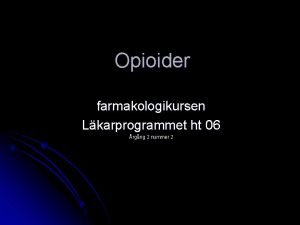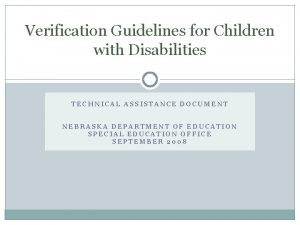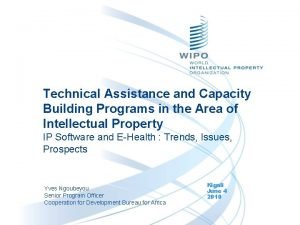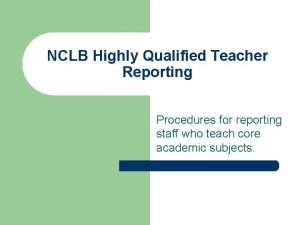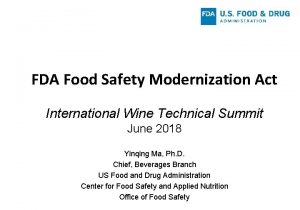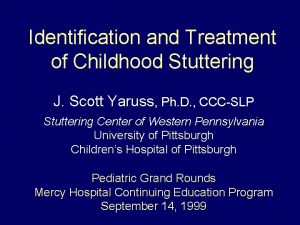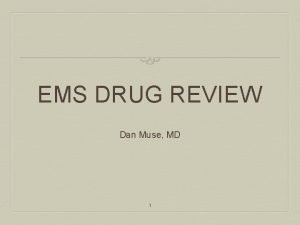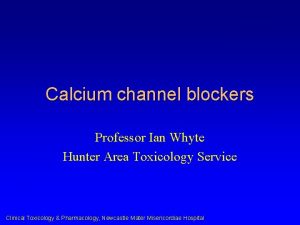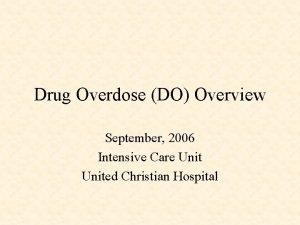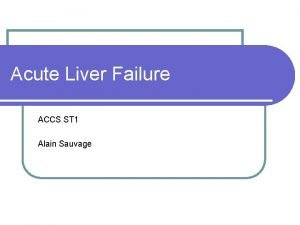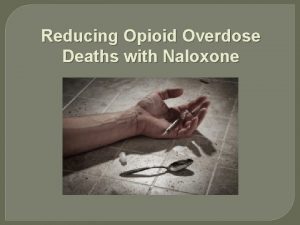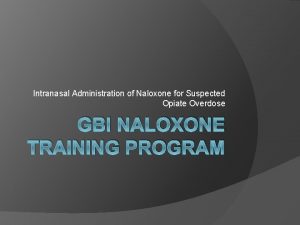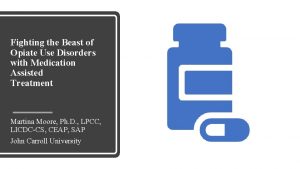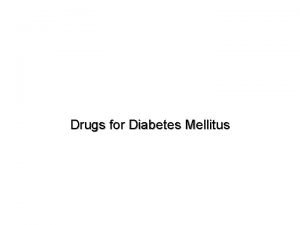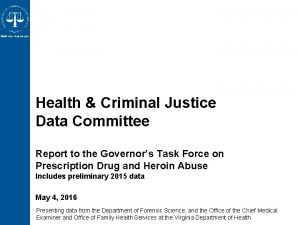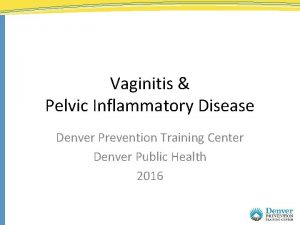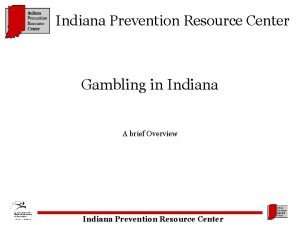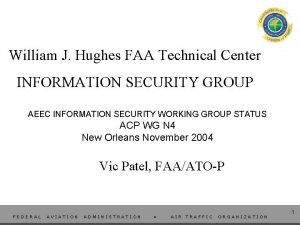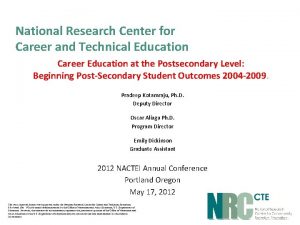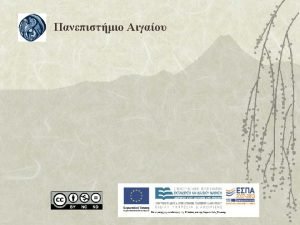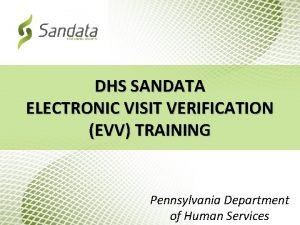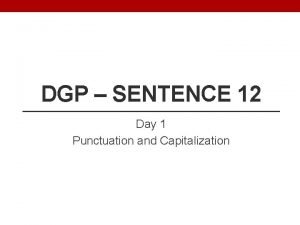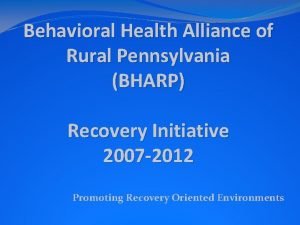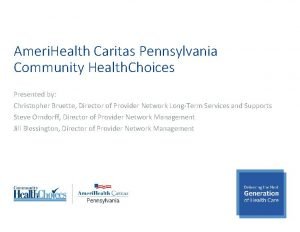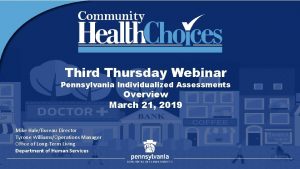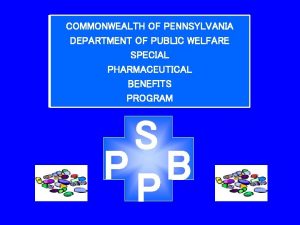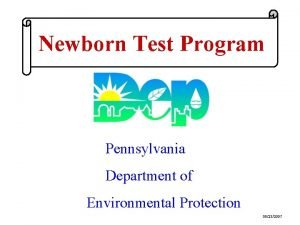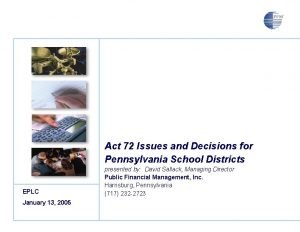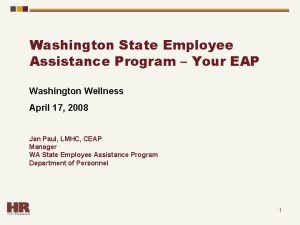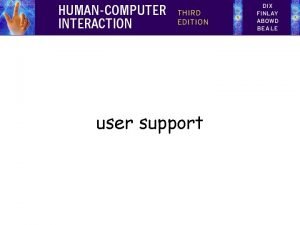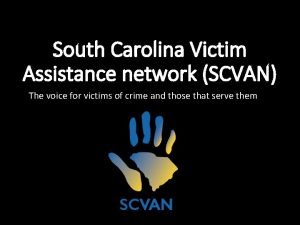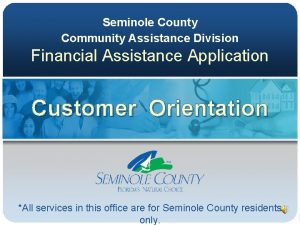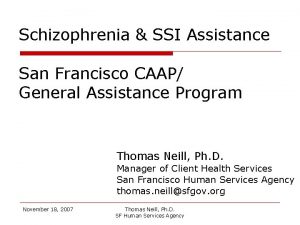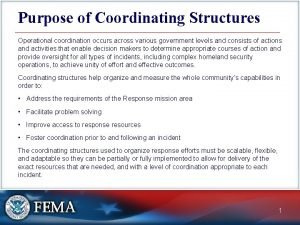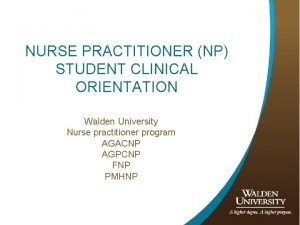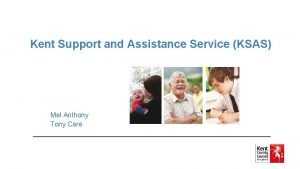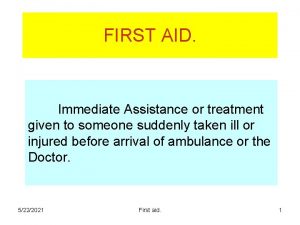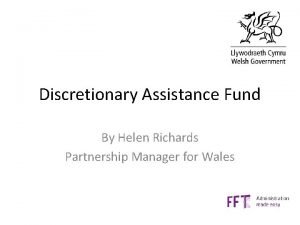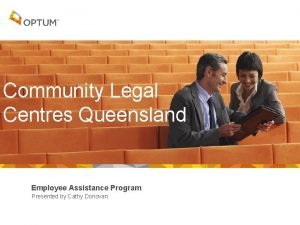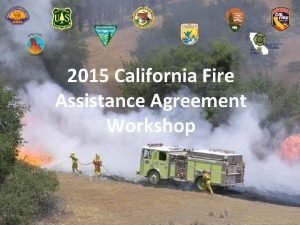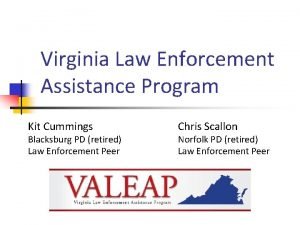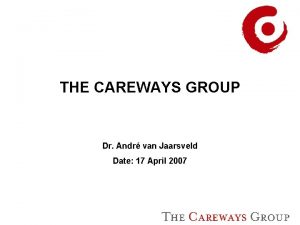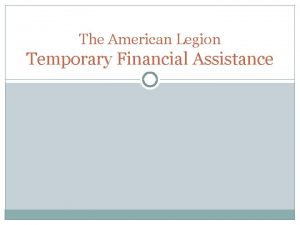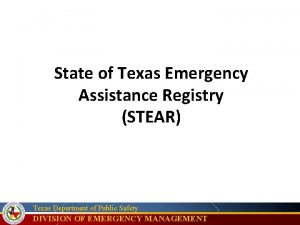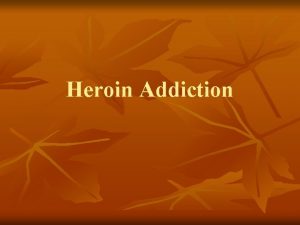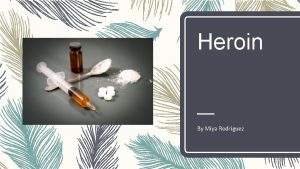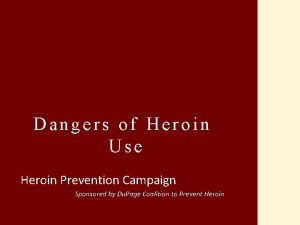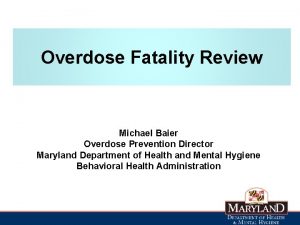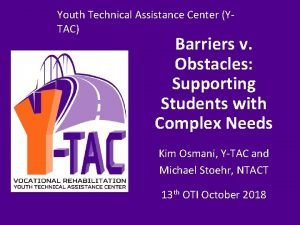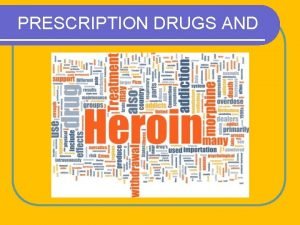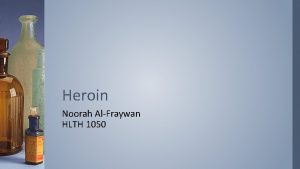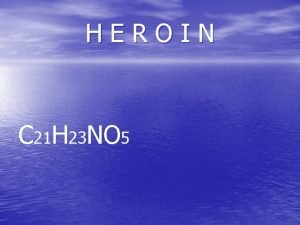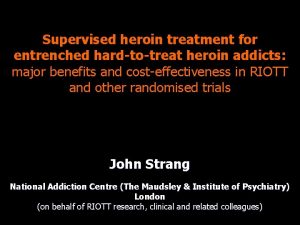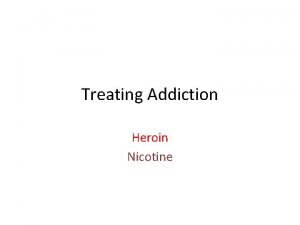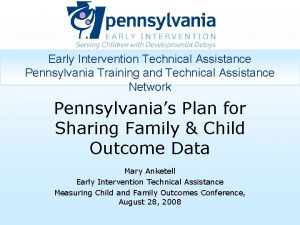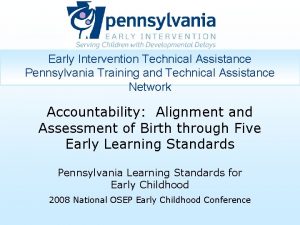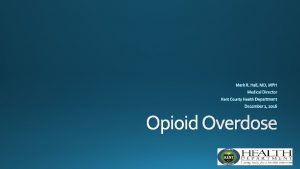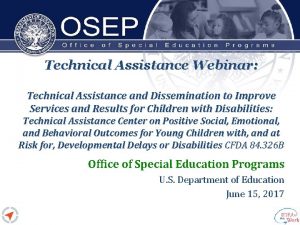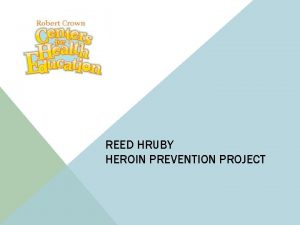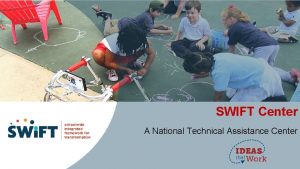The Pennsylvania Heroin Overdose Prevention Technical Assistance Center
































![OVERVIEW [County Name]’s Overdose Death Rate as of [Date] is: T Number of Overdoses OVERVIEW [County Name]’s Overdose Death Rate as of [Date] is: T Number of Overdoses](https://slidetodoc.com/presentation_image_h2/162fdc90d3e8aee36a0f0d1f018c47e7/image-33.jpg)











































































































- Slides: 140

The Pennsylvania Heroin Overdose Prevention Technical Assistance Center Dr. Janice Pringle, Ph. D Principal Investigator Copyright 2016, University of Pittsburgh. All Rights Reserved.

Welcome! Copyright 2016, University of Pittsburgh. All Rights Reserved.

Training Objectives Provide an overview of the TAC and how your coalition can access its services; Review a process developed by the TAC for guiding your community towards organizing itself and implementing strategies that will have a significant impact upon overdoses. Obtain your feedback regarding the services TAC can provide that you feel would be most beneficial to your county; Review next steps in your collaboration with the TAC. Copyright 2016, University of Pittsburgh. All Rights Reserved.

Introductions and Training Goals Copyright 2016, University of Pittsburgh. All Rights Reserved.

TAC Implementation Diagram Assessment A. 1. Describe Your Community Capacity C. 1. Identify Coalition Members C. 2. Develop Coalition Vision A. 2. Obtain Overdose Data Available to Your Community C. 3. Develop Coalition Leadership A. 3. Assess Community Readiness Planning P. 1. Identify Potential Evidence-Based Intervention Strategies P. 2. Develop Impact Model P. 3. Develop Strategic Plan Implementation Evaluation Sustainability I. 1. Determine Relevant Community Stakeholders E. 1. Develop an Evaluation Plan S. 1. Secure Funding Resources I. 2. Develop an Effective Communication Plan E. 2. Measure Progress S. 2. Develop a Sustainability Plan I. 3. Implement Strategies Supporting Continuous Quality and Fidelity C. 4. Maintain Coalition Health C. 5. Ascertain Available Resources and Support C. 6. Determine Community Activation Level C. 7. Determine SUD Treatment Capacity Needed (TBD: Treatment Calculator) Copyright 2016, University of Pittsburgh. All Rights Reserved. S. 3. Obtain Continued Community Support

Today’s Agenda 8: 30 -9: 00 -9: 15 -9: 45 -10: 00 -10: 15 -11: 00 -11: 15 -11: 30 -12: 15 -1: 00 -2: 00 -2: 15 -3: 15 REGISTRATION and CONTINENTAL BREAKFAST Welcome and Training Objectives Janice Pringle, Ph. D Coalition Member Introduction and Training Goals Participants, Facilitated by Janice Pringle, Ph. D Review of Agenda Janice Pringle, Ph. D The PA Heroin Overdose Prevention Technical Assistance Center (TAC) Mission and Vision Statement Janice Pringle, Ph. D The TAC Framework Janice Pringle, Ph. D BREAK Assessment: What Do We (and You) Know About Your Communities? Janice Pringle, Ph. D Capacity: What Capacity Does Your Community Have to Effectively Address Overdoses? Janice Pringle, Ph. D LUNCH Planning: How Do We Develop a Strategic Plan and Identify Potential Practices? Janice Pringle, Ph. D BREAK Implementation: How Can We Best Implement Our Plan? Janice Pringle, Ph. D 3: 15 -3: 45 Evaluation: How Can We Use Our Impact Model to Develop an Evaluation Plan? Allison Burrell, MPH, CPH Laken Ethun, MPH 3: 45 -4: 15 Sustainability: How Can We Sustain Our Efforts to Reduce Overdoses? Janice Pringle, Ph. D 4: 15 -4: 30 Closing Remarks and Next Steps Copyright 2016, University of Pittsburgh. All Rights Reserved.

TAC Mission The Pennsylvania Heroin Overdose Prevention Technical Assistance Center (TAC) will be the first ever resource and technical assistance hub for all counties within the Commonwealth of Pennsylvania. Based out of the Program Evaluation and Research Unit (PERU) at the University of Pittsburgh School of Pharmacy, the TAC will assist counties and communities in effectively planning, developing, implementing, and sustaining community-based initiatives for reducing overdose throughout Pennsylvania. Copyright 2016, University of Pittsburgh. All Rights Reserved.

TAC Vision The TAC will actively work, by providing trainings and concierge technical assistance, to empower and strengthen county coalitions as they plan, develop, implement, and sustain efforts to reduce overdose in their communities. Copyright 2016, University of Pittsburgh. All Rights Reserved.

TAC Framework Copyright 2016, University of Pittsburgh. All Rights Reserved.

Planning Framework Copyright 2016, University of Pittsburgh. All Rights Reserved.

Systems Transformation Framework Copyright 2016, University of Pittsburgh. All Rights Reserved.

Assessment Copyright 2016, University of Pittsburgh. All Rights Reserved.

Objectives Describe the state of overdose in Pennsylvania and the United States; Understand the relationship between prescription opioids and heroin; Discuss risk factors and high-risk populations; Develop a community profile for your county; Assess community readiness using a measurement instrument. Copyright 2016, University of Pittsburgh. All Rights Reserved.

Overdoses are the leading cause of injury death in the United States. Pennsylvania had the 8 th highest overdose rate in 2014. X R 61% of overdose deaths are attributed to prescription opioids and heroin. Copyright 2016, University of Pittsburgh. All Rights Reserved.

The Relationship Between Prescription Opioids and Heroin Copyright 2016, University of Pittsburgh. All Rights Reserved.

Aggressive use of prescription opioids to manage acute and chronic pain began in the 1980 s and led to a marked increase in overdoses in the early 2000 s. Copyright 2016, University of Pittsburgh. All Rights Reserved.

However, heroin deaths have more than tripled since 2010. Why? Copyright 2016, University of Pittsburgh. All Rights Reserved.

A Theoretical Link Between Prescription Opioid and Heroin Use Heroin is a more potent and cheaper alternative to prescription opioids. Many heroin users report prior dependence on prescription opioids. Patient prescribed opioid pain medication. Patient becomes dependent. Provider takes patient off pain medication. Copyright 2016, University of Pittsburgh. All Rights Reserved. Patient turns to heroin.

The Problem with Fentanyl is prescribed to treat “breakout” pain, and heroin can be “cut” with illegally manufactured fentanyl. Fentanyl can be 80 to 100 times more potent than morphine and hundreds of times more potent than “pure” heroin. O N Copyright 2016, University of Pittsburgh. All Rights Reserved. N

How can Community Coalitions Help? Copyright 2016, University of Pittsburgh. All Rights Reserved.

Multidisciplinary coalitions are beneficial for: Conducting community assessments; Obtaining data; Identifying intervening variables; Determining community readiness to address overdose; Selecting and implementing interventions to address overdose. Copyright 2016, University of Pittsburgh. All Rights Reserved.

First, your coalition will need to conduct a community assessment. This will help guide your strategic plan and interventions. Culture Economy Social networks Power structures Norms and values History Current and previous overdose experience Copyright 2016, University of Pittsburgh. All Rights Reserved.

Relevant data is important for your assessment. Collect as much data as possible on overdose deaths, treatment programs and resources available, and naloxone availability. Copyright 2016, University of Pittsburgh. All Rights Reserved.

What puts a person at risk of an overdose? Polysubstance use Co-occurring mental and physical illnesses Long-term opioid use Previous overdose, incarceration, treatment, or detox Copyright 2016, University of Pittsburgh. All Rights Reserved.

Are there specific racial, ethnic, gender, age, or socioeconomic groups in your community affected by or at risk for overdose? Copyright 2016, University of Pittsburgh. All Rights Reserved.

Where do overdoses take place in your community, and what drugs cause most overdoses? Urban or rural areas? Private or public spaces? High or low income neighborhoods? Copyright 2016, University of Pittsburgh. All Rights Reserved.

Your coalition should pay special attention to intervening variables including: Overdose risk factors; Subpopulations most affected by overdose; Community settings where overdoses take place; and Problem drugs within the community. Copyright 2016, University of Pittsburgh. All Rights Reserved.

The TAC will help you determine the readiness of your community to tackle overdose. Communities with LOW readiness will need to increase awareness of overdose within their communities before planning interventions. Communities with HIGH readiness will begin planning and selecting interventions. Copyright 2016, University of Pittsburgh. All Rights Reserved.

Stages of Community Readiness Stage Goal No awareness Increase awareness about the issue of overdose Denial Increase awareness that the problem exists in your community Vague awareness Increase awareness that the community can do something Pre-planning Increase awareness with ideas to address the problem Preparation Gather information and begin to plan Initiation Identify and implement evidence-based programs Stabilization Evaluate and improve programs Confirmation Expand services Professionalization Maintain momentum and continue growth Copyright 2016, University of Pittsburgh. All Rights Reserved.

County Data Review Copyright 2016, University of Pittsburgh. All Rights Reserved.

Analyzing Community Data Start with accurate real-time overdose death data; Look for gaps in resources, community member knowledge/awareness, and healthcare provider knowledge/awareness; Look at standardized survey data; Develop questions that you use the data to answer; Qualitative data can be a good way to understand how a population feels about an intervention and how it should be implemented Copyright 2016, University of Pittsburgh. All Rights Reserved.

TAC Dashboard Copyright 2016, University of Pittsburgh. All Rights Reserved.
![OVERVIEW County Names Overdose Death Rate as of Date is T Number of Overdoses OVERVIEW [County Name]’s Overdose Death Rate as of [Date] is: T Number of Overdoses](https://slidetodoc.com/presentation_image_h2/162fdc90d3e8aee36a0f0d1f018c47e7/image-33.jpg)
OVERVIEW [County Name]’s Overdose Death Rate as of [Date] is: T Number of Overdoses in County HIGH County Average National Average AF PA Average 2013 2014 201 5 Year [County Name]’s Ability to Address Overdose as of [Date] is: MODERATE DR Community Awareness Treatment Opioid Removal 12/18/2021 Naloxone Prescribing Practices Copyright 2016. University of Pittsburgh. All Rights Reserved. 33

OVERDOSE DEATHS The drugs that lead to the most overdoses in your county are: Heroin, Fentanyl, Cocaine, and Alcohol. T Overdoses in your county occur mostly in PARKS in ECONOMICALLY DISADVANTAGED areas. NALOXONE Colored icons indicate that MOST of the entity meets the criteria. Fire Department Police Department Sheriffs RESPONDERS PHARMACIES OVERDOSE RESPONDERS HAVE NALOXONE 4 8 4 6 6 3 0 0 DR 8 8 KEEP NALOXONE IN STOCK SUPPLIED NALOXONE 4 13 AWARE OF STANDING ORDER NALOXONE TRAINED 4 Pharmacies AF EMS Responders OPIOID REMOVAL 0 0 TAKE-BACK PROGRAMS EVERY 3 DROP-OFF BOXES MONTHS 12/18/2021 Copyright 2016. University of Pittsburgh. All Rights Reserved. 34

NUMBER OF TREATMENT FACILITIES T Estimated percentage of treatment needed to impact SUD rates: 32% . 5 1 A 1 B 2 A AF Number of Facilities/Programs in County SUBSTANCE USE DISORDER TREATMENT 2 B 3 A 3 B 3 C 4 A 4 B MAT Pennsylvania Client Placement Criteria Level SBIRT INTERCEPT POINTS Referral No Contact Partial Warm Hand-off Full Warm Handoff Embedded Behavioral Health Unknow n DR PRIMARY CARE Referral With Contact EMERGENCY DEPT JAIL or PRISON PROBATION/PAROLE LAW ENFORCEMENT DRUG COURTS FAITH-BASED ORGS OTHER *Half-shaded circles indicate some points in that category utilize the referral method. Completely shaded circles indicate that all points in the category utilize the referral method. 12/18/2021 Copyright 2016. University of Pittsburgh. All Rights Reserved. 35

PRESCRIBING PRACTICES ARE MOST PRECRIBERS IN YOUR COUNTY. . . 0 56 TRAINED ON OPIOID PRESCRIBING GUIDELINES? FOLLOWING OPIOID PRESCRIBING GUIDELINES? T AWARE OF THE RISKS OF PRESCRIBING OPIOIDS? 0 AF AWARE OF PENNSYLVANIA’ S PDMP? 0 COMMUNITY RESOURCES COMMUNITY AWARENESS Extremely Aware Extremely Unsupportive Extremely Supportive DR SUPPORT OVERDOSE PREVENTION Extremely Unaware SUPPORT OVERDOSE INTERVENTION (NALOXONE) 12/18/2021 Copyright 2016. University of Pittsburgh. All Rights Reserved. 36

Butler County Dashboard Copyright 2016, University of Pittsburgh. All Rights Reserved.

OVERVIEW Butler County’s Overdose Death Rate as of 2015 is: Number of Overdoses in County HIGH PA Average 1 (24. 35) County Average 1 (22. 55) National Average 1 (10. 68) 2013 2014 201 5 Year 1. This is an age specific mortality rate based on the 2010 U. S. Census data. The specific population of interest is U. S. residents 10 years of age and older. Butler County’s Community Readiness as of 2016 is: MODERATE Community Efforts Resources Knowledge of Efforts Community Climate 12/18/2021 Leadership Copyright 2016. University of Pittsburgh. All Rights Reserved. 38

OVERDOSE DEATHS The drugs that lead to the most overdoses in your county are: Heroin, Fentanyl, Methadone, and Alcohol. Overdoses in your county occur mostly in PARKS, STREETS, HOMES WITH OCCUPANTS, and CONVENIENCE STORES in URBAN, TOWN, and SUBURBAN areas. NALOXONE Colored icons indicate that MOST of the entity meets the criteria. EMS Responders Fire Department Police Department Sheriffs Pharmacies RESPONDERS PHARMACIES OVERDOSE RESPONDERS HAVE NALOXONE TRAINED AWARE OF STANDING ORDER SUPPLIED NALOXONE KEEP NALOXONE IN STOCK OPIOID REMOVAL 1 0 TAKE-BACK PROGRAMS EVERY 8 DROP-OFF BOXES MONTHS 12/18/2021 Copyright 2016. University of Pittsburgh. All Rights Reserved. 39

Number of Facilities/Programs in County SUBSTANCE USE DISORDER TREATMENT NUMBER OF TREATMENT FACILITIES Estimated percentage of treatment needed to impact SUD rates: . 5 1 A 1 B 2 A 2 B 3 A 3 B 3 C 4 A 4 B MAT Pennsylvania Client Placement Criteria Level SBIRT INTERCEPT POINTS Referral No Contact Referral With Contact Partial Warm Hand-off Full Warm Handoff Embedded Behavioral Health Unknow n PRIMARY CARE EMERGENCY DEPT JAIL or PRISON PROBATION/PAROLE LAW ENFORCEMENT DRUG COURTS FAITH-BASED ORGS OTHER *Half-shaded circles indicate some points in that category utilize the referral method. Completely shaded circles indicate that all points in the category utilize the referral method. 12/18/2021 Copyright 2016. University of Pittsburgh. All Rights Reserved. 40

PRESCRIBING PRACTICES ARE MOST PRECRIBERS IN YOUR COUNTY. . . AWARE OF PENNSYLVANIA’ S PDMP? AWARE OF THE RISKS OF PRESCRIBING OPIOIDS? TRAINED ON OPIOID PRESCRIBING GUIDELINES? FOLLOWING OPIOID PRESCRIBING GUIDELINES? COMMUNITY RESOURCES COMMUNITY AWARENESS SUPPORT OVERDOSE PREVENTION SUPPORT OVERDOSE INTERVENTION (NALOXONE) 12/18/2021 Extremely Unaware Extremely Aware Extremely Unsupportive Extremely Supportive Copyright 2016. University of Pittsburgh. All Rights Reserved. 41

Venango County Dashboard Copyright 2016, University of Pittsburgh. All Rights Reserved.

OVERVIEW Venango County’s Overdose Death Rate as of 2015 is: Number of Overdoses in County Moderate PA Average 1 (24. 35) County Average* (14. 46) National Average 1 (10. 68) 2013 2014 Year 201 5 1. This is an age specific mortality rate based on the 2010 U. S. Census data. The specific population of interest is U. S. residents 10 years of age and older. Rate is per 100, 000 populations. * Self-reported value Venango County’s Ability to Address Overdose as of 2015 is: MODERATE Community Awareness Treatment Naloxone Opioid Removal 12/18/2021 Prescribing Practices Copyright 2016. University of Pittsburgh. All Rights Reserved. 43

OVERDOSE DEATHS The drugs that lead to the most overdoses in your county are: Heroin and Prescription drugs. Overdoses in your county occur mostly in HOMES WITH OCCUPANTS and PARKED CARS in ECONOMICALLY DISADVANTAGED and ISOLATED RURAL areas. NALOXONE Colored icons indicate that MOST of the entity meets the criteria. EMS Responders Fire Department Police Department Sheriffs Pharmacies RESPONDERS PHARMACIES OVERDOSE RESPONDERS HAVE NALOXONE TRAINED AWARE OF STANDING ORDER SUPPLIED NALOXONE KEEP NALOXONE IN STOCK OPIOID REMOVAL 2 TAKE-BACK PROGRAMS 12/18/2021 3 DROP-OFF BOXES Copyright 2016. University of Pittsburgh. All Rights Reserved. 44

Number of Facilities/Programs in County SUBSTANCE USE DISORDER TREATMENT NUMBER OF TREATMENT FACILITIES Estimated percentage of treatment needed to impact SUD rates: . 5 1 A 1 B 2 A 2 B 3 A 3 B 3 C 4 A 4 B MAT Pennsylvania Client Placement Criteria Level SBIRT INTERCEPT POINTS Referral No Contact Referral With Contact Partial Warm Hand-off Full Warm Handoff Embedded Behavioral Health Unknow n PRIMARY CARE EMERGENCY DEPT JAIL or PRISON PROBATION/PAROLE LAW ENFORCEMENT DRUG COURTS FAITH-BASED ORGS OTHER *Half-shaded circles indicate some points in that category utilize the referral method. Completely shaded circles indicate that all points in the category utilize the referral method. 12/18/2021 Copyright 2016. University of Pittsburgh. All Rights Reserved. 45

Capacity Copyright 2016, University of Pittsburgh. All Rights Reserved.

Objectives Identify community members to be part of your coalition; Develop a vision statement for your community coalition; Design a leadership structure to meet the needs of your coalition; Assess your coalition’s organizational health. Copyright 2016, University of Pittsburgh. All Rights Reserved.

Identifying Your Coalition Members Copyright 2016, University of Pittsburgh. All Rights Reserved.

Identify the best leadership for your coalition. Copyright 2016, University of Pittsburgh. All Rights Reserved.

Ideally, leaders will have a combination of the following traits: Previous leadership experience; Respect in the community; Access to community leaders; “Servant” leadership perspective; Open-mindedness; and An understanding of the issues of overdose and familiarity with the overdose issue in your community. Copyright 2016, University of Pittsburgh. All Rights Reserved.

The best coalition members will be passionate and well informed about the problem. Copyright 2016, University of Pittsburgh. All Rights Reserved.

Examples of Coalition Members Criminal justice Single County Authorities Emergency responders SUD treatment providers Healthcare providers Family and friends Political leaders Schools and colleges Faith-based organizations Copyright 2016, University of Pittsburgh. All Rights Reserved.

Your coalition should be reflective of your community and include representatives from all subgroups. Copyright 2016, University of Pittsburgh. All Rights Reserved.

Developing Your Coalition’s Vision Copyright 2016, University of Pittsburgh. All Rights Reserved.

Your VISION should capture the ideals, goals, and purpose of your organization. Your vision will serve as a compass guiding you towards your coalition’s “true north. ” Copyright 2016, University of Pittsburgh. All Rights Reserved.

Your vision will help your coalition create the framework to get started. Create a timeframe for development; Outline your overall vision for the future; and Incorporate feedback from stakeholders and all organization members. Copyright 2016, University of Pittsburgh. All Rights Reserved.

Organizational Health Copyright 2016, University of Pittsburgh. All Rights Reserved.

Conducting a Coalition Health Assessment Copyright 2016, University of Pittsburgh. All Rights Reserved.

Use a developed framework to assess your coalition’s health and readiness to tackle overdose. EXTERNAL LEARNING LEADERSHIP BEHAVIOR CULTURE VISION INTERNAL LEARNING PERFORMANCE MEASUREMENT STRUCTURE © Copyright 2014, J. Pringle (University of Pittsburgh) and K. Scott. All Rights Reserved. Copyright 2016, University of Pittsburgh. All Rights Reserved.

The coalition health assessment areas include: Relationships Decision-Making Power Conflict Organizational Structure Performance Measurement Internal Learning External Learning Copyright 2016, University of Pittsburgh. All Rights Reserved.

Ascertain Available Resources Support Copyright 2016, University of Pittsburgh. All Rights Reserved.

Available Resources and Support: Ascertain your community’s available resources and support to implement a comprehensive overdose prevention initiative. Copyright 2016, University of Pittsburgh. All Rights Reserved.

Available Resources and Support: Identify ALL of your tested, effective community resources; Identify resources that are not either tested or effective; Identify the GAPS in resources for resources that are not available at all or that are available but in a manner that is untested or of poor quality; Identify the issues and barriers; Identify ways to enhance or expand. Copyright 2016, University of Pittsburgh. All Rights Reserved.

Determine Community Activation Level Copyright 2016, University of Pittsburgh. All Rights Reserved.

Determine Community Activation Level: Community Activation is one step beyond Community Awareness. When communities are activated to work towards solving a problem, they are willing to provide the resources and tools necessary for the problem to be solved. Copyright 2016, University of Pittsburgh. All Rights Reserved.

Substance Use Disorder Treatment Capacity Copyright 2016, University of Pittsburgh. All Rights Reserved.

SUD Treatment Dose Calculator The Substance Use Disorder (SUD) Treatment Dose Calculator is a tool that will be used to estimate the treatment resources needed by a community to reduce the number of overdose deaths. The SUD Treatment Dose Calculator will use community-specific information about substance use disorder and overdose events, along with predictive analytics and modeling, to estimate the treatment resources that may be needed in that community. The resource estimate will provide a brief snap-shot of what resources exist in a community, and what resources have the potential to be beneficial. The community-specific information provided by the calculator will support ongoing strategies used to mitigate the effects of opioid overdose within communities. The model will be useful to organizations and community members, particularly those invested in providing quality SUD treatment and reducing the number of lives lost. Copyright 2016, University of Pittsburgh. All Rights Reserved.

Planning Copyright 2016, University of Pittsburgh. All Rights Reserved.

Objectives Apply community assessment data to build logic models for overdose prevention; Identify evidence-based intervention strategies; Describe key components of evidence-based intervention strategies; and Match interventions to risks identified in logic model. Copyright 2016, University of Pittsburgh. All Rights Reserved.

Intervention Strategies Copyright 2016, University of Pittsburgh. All Rights Reserved.

Intervention Model Institute of Medicine “Protractor” Copyright 2016, University of Pittsburgh. All Rights Reserved.

Choose strategies that are a good CONCEPTUAL and PRACTICAL fit. Conceptual Fit: Does the strategy address the identified problem? Practical Fit: Is the strategy a good match for the characteristics of your community? Copyright 2016, University of Pittsburgh. All Rights Reserved.

Consider the following evidencebased strategies: Naloxone Availability Medication Assisted Treatment R X Prescription Drug Monitoring Programs Copyright 2016, University of Pittsburgh. All Rights Reserved. Opioid Prescription Practices

Naloxone Copyright 2016, University of Pittsburgh. All Rights Reserved.

Naloxone can immediately reverse an opioid overdose. It can be prescribed by a physician or obtained from community pharmacies that distribute naloxone. Copyright 2016, University of Pittsburgh. All Rights Reserved.

Individuals can complete Opioid Overdose Education and Naloxone Distribution Training (OEND). Individuals at high risk of overdose, friends and family of opioid users, and first responders should all have access to naloxone. PA Act 139 permits individuals to assist a person suspected of having an overdose. Copyright 2016, University of Pittsburgh. All Rights Reserved.

Medication Assisted Treatment Copyright 2016, University of Pittsburgh. All Rights Reserved.

Medication Assisted Treatment (MAT) combines behavioral therapy and medications. Patients can be prescribed methadone, buprenorphine, Subutex®, Suboxone® (includes naloxone), naltrexone, Vivitrol® (injectable) and Revia® (oral). Copyright 2016, University of Pittsburgh. All Rights Reserved.

Treatment facilities treat patients based on the Pennsylvania Client Placement Criteria (PCPC). MAT helps reduce the chance of relapse by reducing cravings. Some MAT medications can be used for long periods of time. Copyright 2016, University of Pittsburgh. All Rights Reserved.

There are some limitations to MAT including: Limited capacity for treatment facilities or few facilities that offer MAT; Lack of transportation, childcare, etc. ; Financial and insurance concerns; Drug testing for employment; and Lack of connections from intercept points to treatment (“warm hand-off”). Copyright 2016, University of Pittsburgh. All Rights Reserved.

Some alternative strategies to improve MAT availability include Office Based Opioid Treatment (OBOT) and utilizing law enforcement. Copyright 2016, University of Pittsburgh. All Rights Reserved.

OBOT involves physicians prescribing MAT medications in the office outside of the clinic system. Copyright 2016, University of Pittsburgh. All Rights Reserved.

Alternate sentencing (diversion) can keep individuals out of prison to focus on recovery with close supervision. Copyright 2016, University of Pittsburgh. All Rights Reserved.

Law enforcement can play an instrumental role in connecting individuals to appropriate treatment. Many individuals incarcerated for drug use, or who commit property crimes to obtain money to buy drugs, need access to treatment services if incarcerated. Copyright 2016, University of Pittsburgh. All Rights Reserved.

There are two prevailing models for “Police Assisted Addiction Recovery Initiatives” (PAARI). The Gloucester Massachusetts Police ANGEL Initiative The Arlington, Massachusetts Outreach Initiative Copyright 2016, University of Pittsburgh. All Rights Reserved.

Gloucester ANGEL Initiative Individuals arriving at police stations with drugs or paraphernalia, but seeking help, receive “amnesty”. A volunteer will help the individual connect to a treatment center. The PD partner with local pharmacies to ensure access to Naloxone (and the cost is covered by the PD). Copyright 2016, University of Pittsburgh. All Rights Reserved.

Arlington Outreach Initiative Involves proactive outreach by police officers and clinicians to help individuals develop recovery plans; Clinicians and PD offer community-based meetings and training on substance use and interventions. Copyright 2016, University of Pittsburgh. All Rights Reserved.

Prescription Drug Monitoring Programs (PDMPs) Copyright 2016, University of Pittsburgh. All Rights Reserved.

PDMPs collect data from pharmacies, clinics, and hospitals about dispensed and controlled drugs. These programs can help monitor prescribing practices, reduce overprescribing, and stop “doctor shopping. ” Copyright 2016, University of Pittsburgh. All Rights Reserved.

Reactive vs Proactive PDMPs. Reactive PDMPs “generate solicited reports only in response to a specific inquiry made by a prescriber, dispenser, or other party with appropriate authority”. Proactive PDMPs provide requested reports and “identify and investigate cases, generating unsolicited reports whenever suspicious behavior is detected. ” Copyright 2016, University of Pittsburgh. All Rights Reserved.

Strong PDMPs have: Monitored drugs and reported data; Trained and authorized recipients and designees; Clear standards for accessing and using PDMPs; Linkage to addiction treatment professionals and other state PDMPs; and Continuous evaluations. Copyright 2016, University of Pittsburgh. All Rights Reserved.

Pennsylvania has a PDMP entitled ABC - MAP Users report Schedule II – V drugs within 72 hours of dispensing. Prescribers are required to query the system about prior patient use. Data can be shared with other states that have PDMPs. Copyright 2016, University of Pittsburgh. All Rights Reserved.

Prescribing Practices Copyright 2016, University of Pittsburgh. All Rights Reserved.

This evidence-based practice involves working with physicians to follow prescribing recommendations for opioids. Copyright 2016, University of Pittsburgh. All Rights Reserved.

The Centers for Disease Control and Prevention, American Dental Association, and Pennsylvania Medical Society all have guidelines for prescribing opioids. Copyright 2016, University of Pittsburgh. All Rights Reserved.

The CDC Recommends: Non-opioids for chronic pain; Continual patient evaluation; Utilizing drug monitoring programs; and Low-dose opioids to start, then slowly increase if necessary. Copyright 2016, University of Pittsburgh. All Rights Reserved.

The ADA Recommends: Dental schools should educate about addiction and pain management. Dentists review DEA recommendations. Dentists use responsible prescribing practices. Copyright 2016, University of Pittsburgh. All Rights Reserved.

The PMS Recommends: Begin opioids as a trial before long-term use; Individualize doses and monitor and assess patients continually; Rarely use opioids as a standalone treatment; Discontinue opioid therapy if patient displays drug diversion behaviors. Copyright 2016, University of Pittsburgh. All Rights Reserved.

The PMS Recommends: Non-opioid medications should be used to treat pain first. Lowest dose needed should be used. Methadone should not be prescribed for pain. Emergency departments should not refill opioid medications and should access PDMP as indicated. Copyright 2016, University of Pittsburgh. All Rights Reserved.

Remember, physicians can prescribe naloxone to patients to whom they prescribe opioids. Copyright 2016, University of Pittsburgh. All Rights Reserved.

Patients can dispose of unwanted medications with drug take-back programs. Copyright 2016, University of Pittsburgh. All Rights Reserved.

Developing an Impact Model Copyright 2016, University of Pittsburgh. All Rights Reserved.

Impact Models are useful tools to guide coalitions in their efforts. Impact Model: Situation Part One: Work of Coalition Input Activities Part Two: Results Within Community Outputs Copyright 2016, University of Pittsburgh. All Rights Reserved. Outcomes Impact

Developing a Strategic Plan Copyright 2016, University of Pittsburgh. All Rights Reserved.

Before you develop your strategic plan, review the information you gathered. County characteristics Overdose data Readiness level Coalition composition and health Impact model Evidence-based intervention strategies Copyright 2016, University of Pittsburgh. All Rights Reserved.

Your strategic plan should be developed after completing your community assessment. Use the SMART Framework Smart Measureable Achievable Relevant Time-oriented Copyright 2016, University of Pittsburgh. All Rights Reserved.

Implementation Copyright 2016, University of Pittsburgh. All Rights Reserved.

Objectives Community Implementation Considerations; Identify a timeline for implementation; and Monitor implementation plan: Fidelity; Identify adaptation(s) from your plan. Copyright 2016, University of Pittsburgh. All Rights Reserved.

Determine Relevant Community Connections Start with the easiest organizations and individuals to convince and implement with them first; Make sure that all of your connections include organizations that represent persons of different cultures and perspectives. Always be specific regarding what it is you are offering and need when meeting with an organization or individual Try to engage the entity that has authority over the targeted individuals/organizations for their support of what you are proposing. Always follow through with what you say you will do. Copyright 2016, University of Pittsburgh. All Rights Reserved.

Ensure implementation follows a realistic timeline. Task 1 Task 2 Task 3 Task 4 Task 5 Task 6 Task 5 Copyright 2016, University of Pittsburgh. All Rights Reserved.

Rules Of Use Rule 1: All work must be highly specified as to content, sequence, timing, location and expected outcome; Rule 2: Every customer-supplier connection must be simple and direct, and there must be a binary, yes-or-no, way to send requests and receive responses; Rule 3: The pathway for every product and service must be predefined, simple and direct with no loops or forks Rule 4: Any improvement must be made using the scientific method, under the guidance of a teacher, and close in time, space, and person to the problem and toward the ideal. Copyright 2016, University of Pittsburgh. All Rights Reserved.

Develop an Effective Communication Plan Set the communication goal and objectives Develop key messages that effectively speak to target audiences Identify effective communication techniques and tools channels, Outline accessible communication resources Set and monitor time-lines, milestones and indicators in action plans Write up a communication strategy document Copyright 2016, University of Pittsburgh. All Rights Reserved.

Monitor implementation by considering: FIDELITY: how closely did you follow your implementation plan or impact model? ADAPTATIONS: what changes did you make and did they help or hinder your progress? Copyright 2016, University of Pittsburgh. All Rights Reserved.

Aggregate Potential Community Responses to Overdoses in a Simple 3 - Step Fashion 1 Reducing the Amount of Opioids That Would be Available within the Community. 2 Intervening with People Who Have Overdosed or Who are At Increased Risk for Overdose. Copyright 2016, University of Pittsburgh. All Rights Reserved. 3 Providing High Quality and Effective SUD Treatment.

Evaluation Copyright 2016, University of Pittsburgh. All Rights Reserved.

Objectives Discuss benefits of an evaluation plan; Differentiate between short-term and longterm evaluations; Identify potential evaluation methods; and Identify possible evaluation resources. Copyright 2016, University of Pittsburgh. All Rights Reserved.

Why have an evaluation plan? Integrates stakeholders into the project; Helps identify goals and the metrics to measure those goals; Helps identify potential problems early in your project. Copyright 2016, University of Pittsburgh. All Rights Reserved.

We can use the impact model to develop an evaluation plan. Impact Model: Situation Part One: Work of Coalition Input Activities Part Two: Results Within Community Outputs Copyright 2016, University of Pittsburgh. All Rights Reserved. Outcomes Impact

Your evaluation plan should be completed early in the process. Evaluation Plan Task 2 Task 3 Task 4 Task 5 Task 6 Task 5 Copyright 2016, University of Pittsburgh. All Rights Reserved.

Determine your stakeholders’ deliverables and requirements. Copyright 2016, University of Pittsburgh. All Rights Reserved.

Develop a community baseline to compare your project’s goals. Understanding your community’s baseline conditions will help you establish reasonable benchmarks. Baseline Copyright 2016, University of Pittsburgh. All Rights Reserved.

Create a set of short-term and longterm goals and evaluations. One-Year Evaluation One-Month Evaluation Copyright 2016, University of Pittsburgh. All Rights Reserved.

Include a mixture of evaluation methods throughout the program. Surveys Activity Logs and Progress Reports Interviews Community Data Copyright 2016, University of Pittsburgh. All Rights Reserved.

Include a documentation and reporting plan as part of your evaluation plan. Make sure the report meets the needs of your stakeholders and has their input. QUARTERLY REPORT __________________ QUARTERLY _________ REPORT __________________ Copyright 2016, University of Pittsburgh. All Rights Reserved.

Sustainability and Inclusion Copyright 2016, University of Pittsburgh. All Rights Reserved.

Objectives List sources of funding to sustain your coalition and efforts; Outline key components of grant applications; and Describe your organization and how it can address overdose. Copyright 2016, University of Pittsburgh. All Rights Reserved.

Grants are a potential source of funding for your coalition. Government agencies (national, state, local) Corporate or business donations Foundation sponsors Copyright 2016, University of Pittsburgh. All Rights Reserved.

Things to keep in mind about grants: Specific eligibility rules may apply; Pay close attention to submission deadlines; Ensure all required components are included in the application; and Understand the funder’s role in the project (deliverables, oversight, required analyses, etc. ). Copyright 2016, University of Pittsburgh. All Rights Reserved.

Sustainability plans address how you can maintain your coalition, resources, and connections to ensure long-term effectiveness. Copyright 2016, University of Pittsburgh. All Rights Reserved.

Sustainability is an iterative, continuous process. Project elements will need to be continuously evaluated, timelines adapted, and resources obtained to ensure sustainability. Copyright 2016, University of Pittsburgh. All Rights Reserved.

Identify barriers and strategize solutions to overcome these barriers. Copyright 2016, University of Pittsburgh. All Rights Reserved.

Sustainability requires continued community support Copyright 2016, University of Pittsburgh. All Rights Reserved.

Remember, the TAC is here to help! Copyright 2016, University of Pittsburgh. All Rights Reserved.

Contact Information Intensive Technical Assistance and As Needed Technical Assistance PA Heroin Overdose Prevention TAC Program Evaluation and Research Unit (PERU) The Offices at Baum, 432 5607 Baum Blvd Pittsburgh, PA 15232 (412) 383 -2006 PAoverdose. TAC@pitt. edu Copyright 2016, University of Pittsburgh. All Rights Reserved.


Thank You! Copyright 2016, University of Pittsburgh. All Rights Reserved.

References American Dental Association (n. d. ). Statement on the use of opioids in the treatment of dental pain. Retrieved from http: //www. ada. org/en/about-the-ada/ada-positions-policies-andstatements/statement-on-opioids-dental-pain American Medical Association. (2011). Prescription Drug Monitoring Programs. Baca, C. T. , & Grant, K. J. (2005). Take‐home naloxone to reduce heroin death. Addiction, 100(12), 1823 -1831. Bailey, A. M. , & Wermeling, D. P. (2014). Naloxone for Opioid Overdose Prevention Pharmacists’ Role in Community-Based Practice Settings. Annals of Pharmacotherapy, 1060028014523730. Banta-Green, C. J. , Beletsky, L. , Schoeppe, J. A. , Coffin, P. O. , & Kuszler, P. C. (2013). Police Officers' and Paramedics' Experiences with Overdose and Their Knowledge and Opinions of Washington State's Drug Overdose-Naloxone-Good Samaritan Law. J Urban Health. doi: 10. 1007/s 11524 -013 -9814 -y Barocas, J. A. , Baker, L. , Hull, S. J. , Stokes, S. , & Westergaard, R. P. (2015). High uptake of naloxone-based overdose prevention training among previously incarcerated syringe-exchange program participants. Drug Alcohol Depend, 154, 283 -286. Belenko, S. , Hiller, M. , & Hamilton, L. (2014). Treating Substance Use Disorders in the Criminal Justice System. Retrieved from http: //www. ncbi. nlm. nih. gov/pmc/articles/PMC 3859122/ Bennett, A. S. , Bell, A. , Tomedi, L. , Hulsey, E. G. , & Kral, A. H. (2011). Characteristics of an overdose prevention, response, and naloxone distribution program in Pittsburgh and Allegheny County, Pennsylvania. Journal of Urban Health, 88(6), 1020 -1030. Calcaterra, S. , Glanz, J. , & Binswanger, I. A. (2013). National trends in pharmaceutical opioid related overdose deaths compared to other substance related overdose deaths: 1999 -2009. Drug Alcohol Depend, 131(3), 263 -270. doi: 10. 1016/j. drugalcdep. 2012. 11. 018 Community Catalyst, I. (2003). Strength in numbers: A guide to building community coalitions. Compton, W. M. , Boyle, M. , & Wargo, E. (2015). Prescription opioid abuse: problems and responses. Prev Med, 80, 5 -9. DDAP. (2016). DDAP Treatment Manual. Retrieved from http: //www. ddap. pa. gov/Manuals/Treatment%20 Manual. pdf Doe-Simkins, M. , Walley, A. Y. , Epstein, A. , & Moyer, P. (2009). Saved by the nose: bystander-administered intranasal naloxone hydrochloride for opioid overdose. Am J Public Health, 99(5), 788 -791. doi: 10. 2105/AJPH. 2008. 146647 Dowell, D. , Haegerich, T. M. , & Chou, R. (2016). CDC guideline for prescribing opioids for chronic pain—United States, 2016. JAMA, 315(15), 1624 -1645. Copyright 2016, University of Pittsburgh. All Rights Reserved.

References Drug Enforcement Agency (n. d. ). Drug Fact Sheet: Heroin. Retrieved from http: //www. dea. gov/druginfo/drug_data_sheets/Heroin. pdf FAMM. Alternatives to Incarceration Iin a Nutshell. Retrieved from http: //famm. org/wp-content/uploads/2013/08/FS-Alternatives-ina-Nutshell-7. 8. pdf Friedmann, P. D. , Hoskinson Jr, R. , Gordon, M. , Schwartz, R. , Kinlock, T. , Knight, K. , . . . Sacks, S. (2012). Medication-assisted treatment in criminal justice agencies affiliated with the criminal justice-drug abuse treatment studies (CJ-DATS): availability, barriers, and intentions. Substance Abuse, 33(1), 9 -18. Giglio, R. , Li, G. , & Di. Maggio, C. (2015). Effectiveness of bystander naloxone administration and overdose education programs: a meta-analysis. Injury epidemiology, 2(10). Gray, J. , Hagemeier, N. , Brooks, B. , & Alamian, A. (2015). Prescription Disposal Practices: A 2 -Year Ecological Study of Drug Drop Box Donations in Appalachia. Am J Public Health, 105(9), e 89 -e 94. Hawk, K. F. , Vaca, F. E. , & D'Onofrio, G. (2015). Reducing Fatal Opioid Overdose: Prevention, Treatment and Harm Reduction Strategies. Yale J Biol Med, 88(3), 235 -245. Indivior Inc. (2015). Treatment Plan. Retrieved from http: //www. suboxone. com/treatment-plan/find-adoctor? gclid=CO 7 g 8 r. LHzcw. CFc. Umhgodx. N 0 K 8 w Jones, C. M. (2013). Heroin use and heroin use risk behaviors among nonmedical users of prescription opioid pain relievers– United States, 2002– 2004 and 2008– 2010. Drug Alcohol Depend, 132(1), 95 -100. Longo, D. L. , Compton, W. M. , Jones, C. M. , & Baldwin, G. T. (2016). Relationship between Nonmedical Prescription-Opioid Use and Heroin Use. New England Journal of Medicine, 374(2), 154 -163. Lott, D. C. , & Rhodes, J. (2016). Opioid overdose and naloxone education in a substance use disorder treatment program. The American Journal on Addictions, 25(3), 221 -226. Maxwell, S. , Bigg, D. , Stanczykiewicz, K. , & Carlberg-Racich, S, . (2006). Prescribing naloxone to actively injecting heroin users: a program to reduce heroin overdose deaths. Journal of Addictive Diseases, 25(3), 89– 96. Retrieved from http: //www. ncbi. nlm. nih. gov/pubmed/16956873 Miller, N. (2013). RSAT Training Tool. Retrieved from http: //www. rsat-tta. com/Files/Trainings/Final. MAT Morrison, R. T. , G. (2016). NASADAD. Retrieved from http: //nasadad. org/wp-content/uploads/2016/01/16 -January-12 -Exec-Dirs. Roundtable. pdf Copyright 2016, University of Pittsburgh. All Rights Reserved.

References NAMA. (2016). Office Based Opioid Treatment (OBOT) Retrieved from http: //www. methadone. org/library/obot_resources. html National Alliance for Model State Drug Laws. (2015 a). Annual Review of Prescription Monitoring Programs. Retrieved from http: //www. namsdl. org/library/3449 DDCF-BB 94 -288 B-049 EB 9 A 92 BAD 73 DF/ National Alliance for Model State Drug Laws. (2015 b). Components of a Strong Prescription Monitoring Program. Retrieved from http: //www. namsdl. org/library/8 B 509 B 0 A-D 51 E-472 E-B 9 F 10054 CE 52 F 2 F 6/ National Institute on Drug Abuse. (2012). Fentanyl. Retrieved from https: //www. drugabuse. gov/drugs-abuse/fentanyl Organization, W. H. (2014). Community Management of Opioid Overdose. Geneva: World Health Organization. Retrieved from http: //www. ncbi. nlm. nih. gov/books/NBK 264311/ Paulozzi, L. J. , & Xi, Y. (2008). Recent changes in drug poisoning mortality in the United States by urban-rural status and by drug type. Pharmacoepidemiol Drug Saf, 17(10), 997 -1005. doi: 10. 1002/pds. 1626. Pennsylvania Medical Society. (2014 a). Pennsylvania guidelines emergency department (ED) pain treatment guideline. Retrieved from https: //www. pamedsoc. org/PAMED_Downloads/PA%20 ED%20 Guidelines%20 Opioids. pdf Pennsylvania Medical Society. (2014 b). Pennsylvania guidelines on the use of opioids to treat chronic noncancer pain. Retrieved from https: //www. pamedsoc. org/PAMED_Downloads/PAGuidelineson. Opioids. pdf Project Lazarus. (2007). Policy briefing document. Retrieved from http: //intranasal. net/Peer%20 Reviewed%20 literature/Project%20 Lazarus, %20 North%20 Carolina%20 IN%20 Naloxone %202007. pdf Ray, B. , O’Donnell, D. , & Kahre, K. (2015). Police officer attitudes towards intranasal naloxone training. Drug Alcohol Depend, 146, 107 -110. Rosenblum, A. , Marsch, L. A. , Joseph, H. , & Portenoy, R. K. (2008). Opioids and the treatment of chronic pain: controversies, current status, and future directions. Exp Clin Psychopharmacol, 16(5), 405. Rudd, R. A. , Aleshire, N. , Zibbell, J. E. , & Gladden, R. M. (2016). Increases in drug and opioid overdose deaths-United States, 2000 -2014. MMWR: Morbidity and mortality weekly report, 64(50 -51), 1378 -1382. Copyright 2016, University of Pittsburgh. All Rights Reserved.

References SAMHSA. Buprenorphine. Retrieved from http: //buprenorphine. samhsa. gov/faq. html#A 1 SAMHSA. Insurance and Payments. Retrieved from http: //www. samhsa. gov/medication-assistedtreatment/insurance-payments SAMHSA. Medications Used in MAT. Retrieved from http: //www. samhsa. gov/medication-assistedtreatment/treatment#medications-used-in-mat SAMHSA. (2016 a). Emerging Issues in Behavioral Health and the Criminal Justice System. Retrieved from http: //www. samhsa. gov/criminal-juvenile-justice/behavioral-health-criminal-justice SAMHSA. (2016 b). Medication-Assisted Treatment (MAT). Retrieved from http: //www. samhsa. gov/medicationassisted-treatment Substance Abuse and Mental Health Services Administration. (2016). Opioid Overdose Prevention Toolkit. Retrieved from http: //store. samhsa. gov/shin/content//SMA 16 -4742. pdf Substance Abuse and Mental Health Services Administration. (2015, 9/24/15). Stages of Community Readiness. Retrieved from http: //www. samhsa. gov/capt/tools-learning-resources/stages-community-readiness The Network for Public Health Law, D. O. P. i. P. (2014). Act 139 Fact Sheet. Retrieved from https: //www. networkforphl. org/_asset/9 r 6 xcz/PA-overdose-prevention. pdf University of Kansas Work Group for Community Health and Development. (2015). The Community Tool Box. Retrieved from http: //ctb. ku. edu/en/toolkits U. S. Department of Health and Human Services. (2008). Medication-Assisted Treatment Retrieved from http: //buprenorphine. samhsa. gov/tip 43_curriculum. pdf U. S. Department of Housing and Urban Development. (2009). Building effective coalitions. U. S. Department of Housing and Urban Development Office of Community Planning and Development. Retrieved from https: //www. hudexchange. info/resources/documents/Building. Effective. Coalitions. pdf VCHIP. Vermont Guidelines for Medication Assisted Treatment (MAT) for Pregnant Women. Retrieved from https: //www. uvm. edu/medicine/vchip/documents/VCHIP_4 MAT_GUIDELINES. pdf Wagner, K. D. , Liu, L. , Davidson, P. J. , Cuevas-Mota, J. , Armenta, R. F. , & Garfein, R. S. (2015). Association between non-fatal opioid overdose and encounters with healthcare and criminal justice systems: Identifying opportunities for intervention. Drug Alcohol Depend, 153, 215 -220. Wakeman, S. E. , Bowman, S. E. , Mc. Kenzie, M. , Jeronimo, A. , & Rich, J. D. (2009). Preventing death among the recently incarcerated: an argument for naloxone prescription before release. J Addict Dis, 28(2), 124 Copyright 2016, University of Pittsburgh. All Rights Reserved. 129.
 Primary prevention secondary prevention tertiary prevention
Primary prevention secondary prevention tertiary prevention Cave morfin
Cave morfin Nde rule 51 technical assistance document
Nde rule 51 technical assistance document Sample technical assistance given to teachers
Sample technical assistance given to teachers Technical assistance plan for teachers deped sample
Technical assistance plan for teachers deped sample Technical assistance plan for teachers deped sample
Technical assistance plan for teachers deped sample Fda technical assistance network
Fda technical assistance network What causes stuttering
What causes stuttering Vitamin b6 overdose symptoms
Vitamin b6 overdose symptoms Tricyclic antidepressants overdose
Tricyclic antidepressants overdose Magnesium overdose
Magnesium overdose Dan muse
Dan muse Glucagon for beta blocker overdose
Glucagon for beta blocker overdose Zoplicone overdose
Zoplicone overdose Hepatic encephalopathy stages
Hepatic encephalopathy stages Opioid overdose
Opioid overdose Opioid overdose
Opioid overdose Opioid overdose
Opioid overdose Metformin overdose
Metformin overdose Dcjs.virginia.gov
Dcjs.virginia.gov Role vitamin a
Role vitamin a Caffeine
Caffeine Travel assistance center
Travel assistance center Cabrini center for immigrant legal assistance
Cabrini center for immigrant legal assistance Denver prevention training center
Denver prevention training center Indiana prevention resource center
Indiana prevention resource center William j. hughes technical center
William j. hughes technical center William j. hughes technical center
William j. hughes technical center Hanson center for technical communication
Hanson center for technical communication National research center for career and technical education
National research center for career and technical education Wjh technical center
Wjh technical center Osha salt lake technical center
Osha salt lake technical center Pennsylvania state plane coordinate system
Pennsylvania state plane coordinate system Piedmont region pa
Piedmont region pa Rachel carson was born in 1907
Rachel carson was born in 1907 Pennsylvania
Pennsylvania Xoom energy pennsylvania
Xoom energy pennsylvania New hire reporting program
New hire reporting program New york, new jersey, pennsylvania, and delaware
New york, new jersey, pennsylvania, and delaware Electronic visit verification pennsylvania
Electronic visit verification pennsylvania My uncle from pittsburgh pennsylvania
My uncle from pittsburgh pennsylvania Bharp
Bharp Amerihealth caritas pa community healthchoices
Amerihealth caritas pa community healthchoices Pennsylvania ecosystems
Pennsylvania ecosystems Pennsylvania dutch council
Pennsylvania dutch council Modern real estate practice in pennsylvania
Modern real estate practice in pennsylvania Prescriptive easement pennsylvania
Prescriptive easement pennsylvania Pennsylvania forest products association
Pennsylvania forest products association Pennsylvania association of school business officials
Pennsylvania association of school business officials Mayflower compact significance
Mayflower compact significance Hanifin rajka atopic dermatitis
Hanifin rajka atopic dermatitis The southernmost part of pennsylvania was once called
The southernmost part of pennsylvania was once called Summer key for pennsylvania trees
Summer key for pennsylvania trees Nfce pennsylvania
Nfce pennsylvania Pennsylvania
Pennsylvania Liquor liability insurance pennsylvania
Liquor liability insurance pennsylvania Modern real estate practice in pennsylvania
Modern real estate practice in pennsylvania Spbp application
Spbp application California university of pennsylvania global online
California university of pennsylvania global online A harvest of death gettysburg pennsylvania
A harvest of death gettysburg pennsylvania Homestead pennsylvania tourism
Homestead pennsylvania tourism Pennsylvania state animal response team
Pennsylvania state animal response team Pennsylvania space grant consortium
Pennsylvania space grant consortium Free radon test kit pa
Free radon test kit pa John yelenic dentist
John yelenic dentist Act 72 pennsylvania
Act 72 pennsylvania Hình ảnh bộ gõ cơ thể búng tay
Hình ảnh bộ gõ cơ thể búng tay Frameset trong html5
Frameset trong html5 Bổ thể
Bổ thể Tỉ lệ cơ thể trẻ em
Tỉ lệ cơ thể trẻ em Chó sói
Chó sói Chụp tư thế worms-breton
Chụp tư thế worms-breton Bài hát chúa yêu trần thế alleluia
Bài hát chúa yêu trần thế alleluia Các môn thể thao bắt đầu bằng tiếng đua
Các môn thể thao bắt đầu bằng tiếng đua Thế nào là hệ số cao nhất
Thế nào là hệ số cao nhất Các châu lục và đại dương trên thế giới
Các châu lục và đại dương trên thế giới Công thức tiính động năng
Công thức tiính động năng Trời xanh đây là của chúng ta thể thơ
Trời xanh đây là của chúng ta thể thơ Cách giải mật thư tọa độ
Cách giải mật thư tọa độ Làm thế nào để 102-1=99
Làm thế nào để 102-1=99 Phản ứng thế ankan
Phản ứng thế ankan Các châu lục và đại dương trên thế giới
Các châu lục và đại dương trên thế giới Thể thơ truyền thống
Thể thơ truyền thống Quá trình desamine hóa có thể tạo ra
Quá trình desamine hóa có thể tạo ra Một số thể thơ truyền thống
Một số thể thơ truyền thống Bàn tay mà dây bẩn
Bàn tay mà dây bẩn Vẽ hình chiếu vuông góc của vật thể sau
Vẽ hình chiếu vuông góc của vật thể sau Thế nào là sự mỏi cơ
Thế nào là sự mỏi cơ đặc điểm cơ thể của người tối cổ
đặc điểm cơ thể của người tối cổ V. c c
V. c c Vẽ hình chiếu đứng bằng cạnh của vật thể
Vẽ hình chiếu đứng bằng cạnh của vật thể Phối cảnh
Phối cảnh Thẻ vin
Thẻ vin đại từ thay thế
đại từ thay thế điện thế nghỉ
điện thế nghỉ Tư thế ngồi viết
Tư thế ngồi viết Diễn thế sinh thái là
Diễn thế sinh thái là Dot
Dot Số nguyên tố là gì
Số nguyên tố là gì Tư thế ngồi viết
Tư thế ngồi viết Lời thề hippocrates
Lời thề hippocrates Thiếu nhi thế giới liên hoan
Thiếu nhi thế giới liên hoan ưu thế lai là gì
ưu thế lai là gì Hổ sinh sản vào mùa nào
Hổ sinh sản vào mùa nào Khi nào hổ mẹ dạy hổ con săn mồi
Khi nào hổ mẹ dạy hổ con săn mồi Hệ hô hấp
Hệ hô hấp Từ ngữ thể hiện lòng nhân hậu
Từ ngữ thể hiện lòng nhân hậu Thế nào là mạng điện lắp đặt kiểu nổi
Thế nào là mạng điện lắp đặt kiểu nổi Weatherization assistance program virginia
Weatherization assistance program virginia Eap washington
Eap washington Types of user support in hci
Types of user support in hci Writ of assistance
Writ of assistance Nc victim assistance network
Nc victim assistance network Social assistance definition
Social assistance definition Seminole county rental assistance
Seminole county rental assistance General assistance in san francisco
General assistance in san francisco Sets sagkeeng
Sets sagkeeng First time homebuyer riverside
First time homebuyer riverside How do coordination structures help organize and measure
How do coordination structures help organize and measure Nehemiah down payment assistance
Nehemiah down payment assistance Walden university fnp
Walden university fnp Ksas application form
Ksas application form Chancery hisd
Chancery hisd Immediate assistance
Immediate assistance Social assistance definition
Social assistance definition Discretionary assistance fund
Discretionary assistance fund Cplp down payment assistance
Cplp down payment assistance Employee assistance program townsville
Employee assistance program townsville Kaiser permanente community benefit program
Kaiser permanente community benefit program Nevada’s autism treatment assistance program
Nevada’s autism treatment assistance program California fire assistance agreement
California fire assistance agreement Valeap
Valeap Usf 247
Usf 247 Urban league liheap
Urban league liheap Careways employee assistance program
Careways employee assistance program American legion temporary financial assistance
American legion temporary financial assistance Texas department of public safety
Texas department of public safety Nslsc
Nslsc Industrial research assistance program
Industrial research assistance program Weatherization assistance program missouri
Weatherization assistance program missouri Leveraging educational assistance partnership
Leveraging educational assistance partnership

